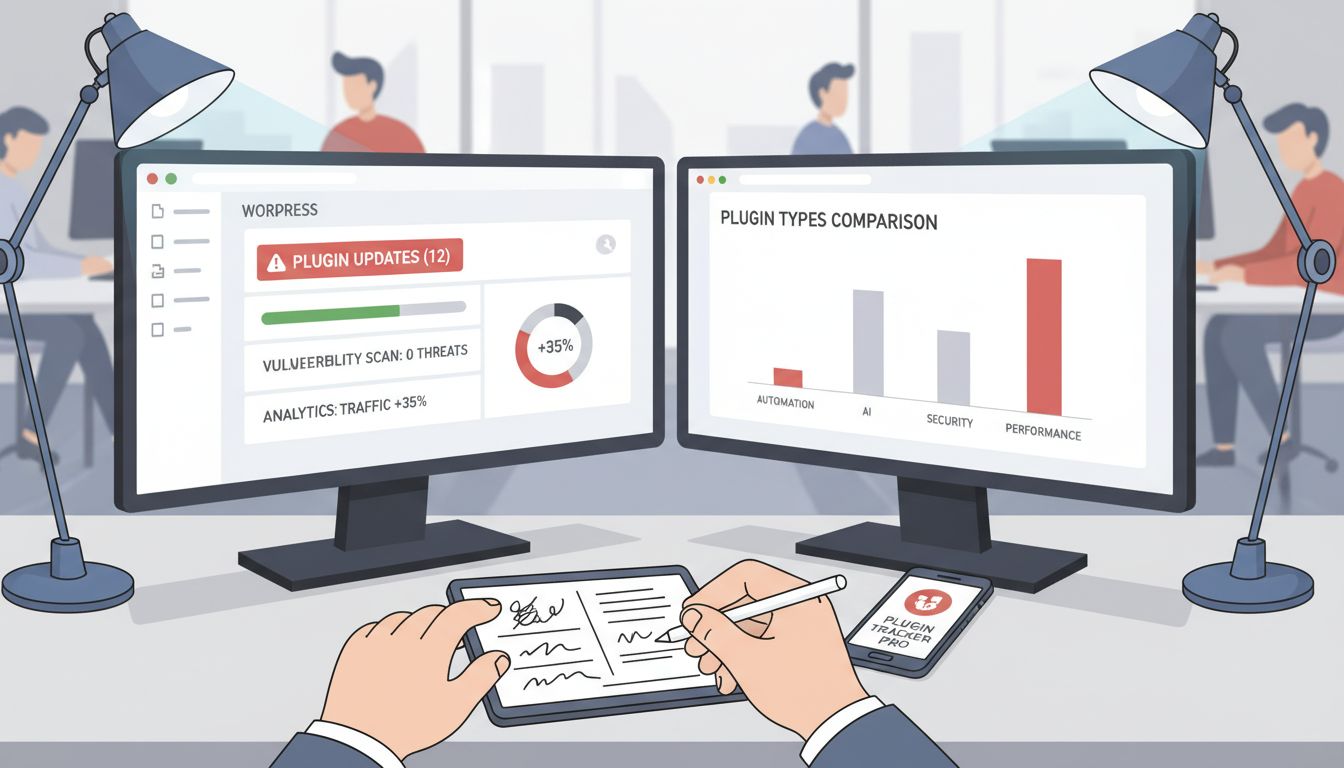Over 60,000 plugins now power WordPress websites, shaping the way millions build and run their online presence. The surge in plugin development has not only transformed website functionality but also introduced new challenges and opportunities for users and developers alike. From smarter automation and tighter security to the latest in AI, understanding these trends helps anyone navigating WordPress to stay ahead in a fast-evolving digital space.
Key Takeaways
| Point | Details |
|---|---|
| Plugin Growth | The WordPress ecosystem features over 60,000 plugins, with significant growth attributed to developers’ commitment to enhancing digital capabilities. |
| Security and Performance Focus | Innovations prioritize security, performance optimization, and user experience, addressing market needs and evolving user expectations. |
| AI and Automation Trends | AI-powered solutions and automation plugins are redefining efficiency, enabling intelligent user experiences and streamlined workflows. |
| Dynamic Plugin Lifecycle | Modern plugins are continuously evolving to align with technological advancements, emphasizing the importance of strategic selection and ongoing maintenance. |
Defining Plugin Trends in WordPress Ecosystem
The WordPress ecosystem has transformed dramatically, emerging as a dynamic landscape where plugin development represents more than just code enhancement. According to research from WordPress Plugin Directory Analysis, the platform now hosts over 60,000 plugins, reflecting an extraordinary growth trajectory that underscores developers’ commitment to expanding digital functionality.
Plugin trends are not merely about quantity but about solving specific user challenges. These trends emerge from critical market needs, technological shifts, and community feedback. Security, performance optimization, and user experience have become primary drivers of plugin innovation. Research indicates that while plugins offer immense potential, they simultaneously introduce complex vulnerabilities that demand ongoing maintenance and strategic selection.
Key characteristics defining contemporary WordPress plugin trends include:
- Microservice-oriented functionality
- Enhanced security protocols
- AI and machine learning integrations
- Lightweight, performance-focused designs
- Cross-platform compatibility
Interestingly, as we explore WordPress Plugin Detector Test 2025, the ecosystem reveals a sophisticated maturity. Developers now prioritize creating solutions that are not just feature-rich but also strategically aligned with emerging web technologies and user expectations.
Types of Plugin Trends and Their Lifecycle
The WordPress plugin ecosystem is experiencing a profound transformation, driven by specialized and innovative development strategies. According to The Editors Suite, emerging trends showcase a remarkable shift towards industry-specific solutions and AI-powered tools that address nuanced user requirements.
Plugin trends can be categorized into several distinct archetypes that reflect the evolving digital landscape:
Here’s a comparison of common WordPress plugin trend types and their primary features:
| Plugin Trend Type | Main Purpose | Example Features |
|---|---|---|
| Automation Plugins | Workflow streamlining | Automated tasks Bulk actions |
| AI-Powered Solutions | Intelligent user experiences | Content generation Chatbots |
| Industry-Specific Plugins | Niche market solutions | E-commerce tools Booking systems |
| Performance Optimization | Speed & efficiency | Caching Image compression |
| Security-Centric Plugins | Protection & compliance | Malware scanning Firewall options |
- Automation Plugins: Tools that streamline workflow and reduce manual interventions
- AI-Powered Solutions: Intelligent plugins leveraging machine learning
- Industry-Specific Plugins: Tailored solutions for sectors like hospitality, recruitment, and e-commerce
- Performance Optimization Plugins: Focused on site speed and user experience
- Security-Centric Plugins: Advanced protection mechanisms
The lifecycle of these plugins is increasingly dynamic.
Research from Market Clarity indicates a significant shift towards full-site editing capabilities and intelligent website management solutions. Modern plugins are no longer static tools but adaptive, continuously evolving platforms that respond to technological advancements and changing user expectations.
As we explore The State of WordPress SEO Plugins in 2025, it becomes evident that successful plugins must balance innovation, performance, and user-centric design to remain relevant in this rapidly transforming digital ecosystem.
Key Drivers Influencing Plugin Popularity
The WordPress plugin ecosystem is experiencing unprecedented growth, driven by sophisticated market dynamics and evolving digital needs. According to Accio Research, the plugin market is currently valued at a staggering $12.5 billion, with projections indicating a robust 14.3% Compound Annual Growth Rate (CAGR) through 2028. This expansion reflects the critical role of specialized functionalities in modern web development.
Key drivers influencing plugin popularity emerge from multiple strategic dimensions:
- User Experience Enhancement: Plugins that simplify complex tasks
- Performance Optimization: Tools improving site speed and efficiency
- Security Innovations: Advanced protection mechanisms
- Mobile Responsiveness: Adaptive design capabilities
- Integration Capabilities: Seamless connectivity with external platforms
With WordPress powering 43.5% of global websites, as highlighted by Amraa and Elma, the demand for versatile and intelligent plugins has never been more pronounced. Developers and site owners seek solutions that not only address immediate functional requirements but also anticipate future technological shifts.
As we explore The Best WordPress Page Builders in 2025, it becomes evident that successful plugins must offer more than basic functionality. They must provide innovative, user-centric solutions that adapt to the rapidly evolving digital landscape.
Practical Uses for Developers and Marketers
WordPress plugins have transformed from simple add-ons to strategic tools that empower developers and marketers to create more intelligent, responsive digital experiences. According to Ikonik Digital, AI-driven plugins are revolutionizing task automation, enabling professionals to streamline operations and dramatically boost user engagement.
Practical applications for developers and marketers include:
- Automated Content Generation: AI plugins that draft blog posts and marketing materials
- Customer Support Optimization: Intelligent chatbots and support ticket management
- Performance Analytics: Advanced tracking and user behavior insights
- Security Enhancement: Machine learning-powered threat detection
- Personalization Engines: Dynamic content adaptation based on user profiles
As highlighted by The Inscriber Magazine, integrating AI and machine learning into plugins enables more efficient website development. These technologies provide unprecedented opportunities to create adaptive, intelligent web experiences that respond dynamically to user needs.
For deeper insights into technological tools that power these innovations, explore BuiltWith vs Wappalyzer vs WPoptic, which offers comprehensive analysis of web technology detection and competitive intelligence.
Monitoring Trends: Tools and Data Sources
The WordPress ecosystem is a dynamic landscape that demands sophisticated monitoring strategies. According to WP Engine Research, tracking data from theme and plugin marketplaces provides crucial insights into growth patterns, revenue streams, and geographic distribution of top-performing developers.
Key monitoring approaches for trend analysis include:
- Marketplace Analytics: Tracking submission rates and revenue metrics
- Community Submission Tracking: Analyzing plugin directory growth
- Performance Benchmarking: Evaluating plugin adoption and user ratings
- Geographic Distribution: Mapping developer ecosystems globally
- Revenue Trend Identification: Understanding market value shifts
Recent data from the WordPress Plugins Team reveals a remarkable trend, with plugin submissions doubling in 2025. This exponential growth underscores the critical importance of robust trend monitoring tools that can navigate the rapidly evolving digital landscape.
For professionals seeking comprehensive insights, WPoptic’s analysis tools offer an advanced approach to understanding WordPress plugin ecosystems, providing deep-dive analytics that go beyond surface-level trends.
Risks, Pitfalls, and Compliance Considerations
The WordPress plugin ecosystem presents complex security challenges that demand strategic vigilance. According to research from ArXiv Security Analysis, plugins with large installation bases represent significant potential vulnerability points, necessitating rigorous security management and continuous monitoring.
Key risks and compliance considerations include:
- Vulnerability Exposure: Potential security breaches through outdated plugins
- Compatibility Challenges: Conflicts between multiple plugin configurations
- Performance Degradation: Excessive plugin usage impacting site speed
- Legal Compliance: Adhering to data protection regulations
- Update Management: Maintaining consistent plugin maintenance cycles
Advanced cybersecurity research suggests implementing sophisticated cyber deception techniques to mitigate potential exploits. Cutting-edge research from ArXiv recommends obfuscation strategies that make WordPress environments significantly more challenging for potential attackers to penetrate.
For professionals seeking comprehensive plugin security insights, WPoptic’s WordPress Plugin Detector offers advanced tools for identifying and analyzing potential security risks within plugin ecosystems.
Unlock the Power of WordPress Plugin Insights with WPoptic
WordPress plugin trends shape the future of digital experiences but also introduce challenges like security risks and performance issues. If you strive to stay ahead by understanding plugin popularity, detection, and evolving market demands WPoptic offers the perfect solution. Our platform helps you analyze plugin configurations with precision so you can make smarter decisions that enhance security and boost performance.
Discover how to leverage detailed plugin data through our lead list creation tool for targeted outreach and competitor analysis. Don’t wait until vulnerabilities impact your site or your campaigns fall behind. Visit WPoptic now to gain a competitive edge with comprehensive WordPress ecosystem intelligence and transform your approach to plugin monitoring and growth.
Frequently Asked Questions
What are the current trends in WordPress plugin development?
Current trends in WordPress plugin development include microservice-oriented functionality, enhanced security protocols, AI and machine learning integrations, lightweight performance-focused designs, and cross-platform compatibility.
How do plugin trends address user challenges?
Plugin trends emerge from critical market needs, technological shifts, and community feedback, focusing on solving specific user challenges such as security vulnerabilities, performance optimization, and enhancing user experience.
What are some types of WordPress plugins and their purposes?
Some common types of WordPress plugins include automation plugins for workflow streamlining, AI-powered solutions for intelligent experiences, industry-specific plugins for niche markets, performance optimization plugins for improving site speed, and security-centric plugins for protection and compliance.
What should developers consider when creating WordPress plugins?
Developers should prioritize user experience, ensure performance optimization, focus on security innovations, and maintain mobile responsiveness and integration capabilities with external platforms when creating WordPress plugins.
Recommended
- The State of WordPress SEO Plugins in 2025 – WPoptic
- WordPress Plugin Detector Test 2025: What Plugins Is This Site Using? – WPoptic
- The Best WordPress Page Builders in 2025: Real-World Usage Data from WPoptic – WPoptic
- WPoptic – Detect What WordPress Sites Are Built With
- Best WordPress Automatic Internal Links – Expert Comparison 2025
- Understanding SEO Best Practices for Your Business – My Blog




